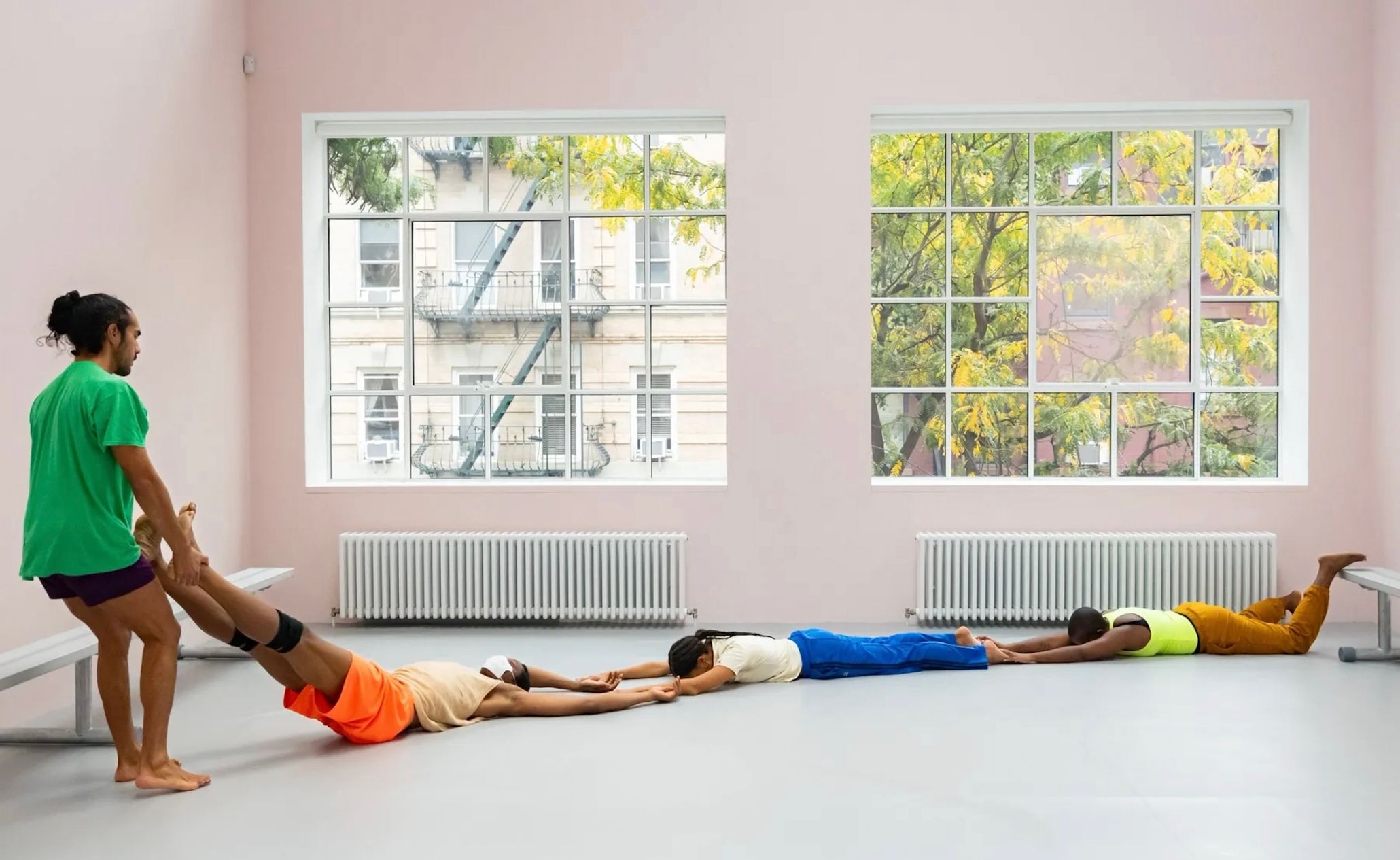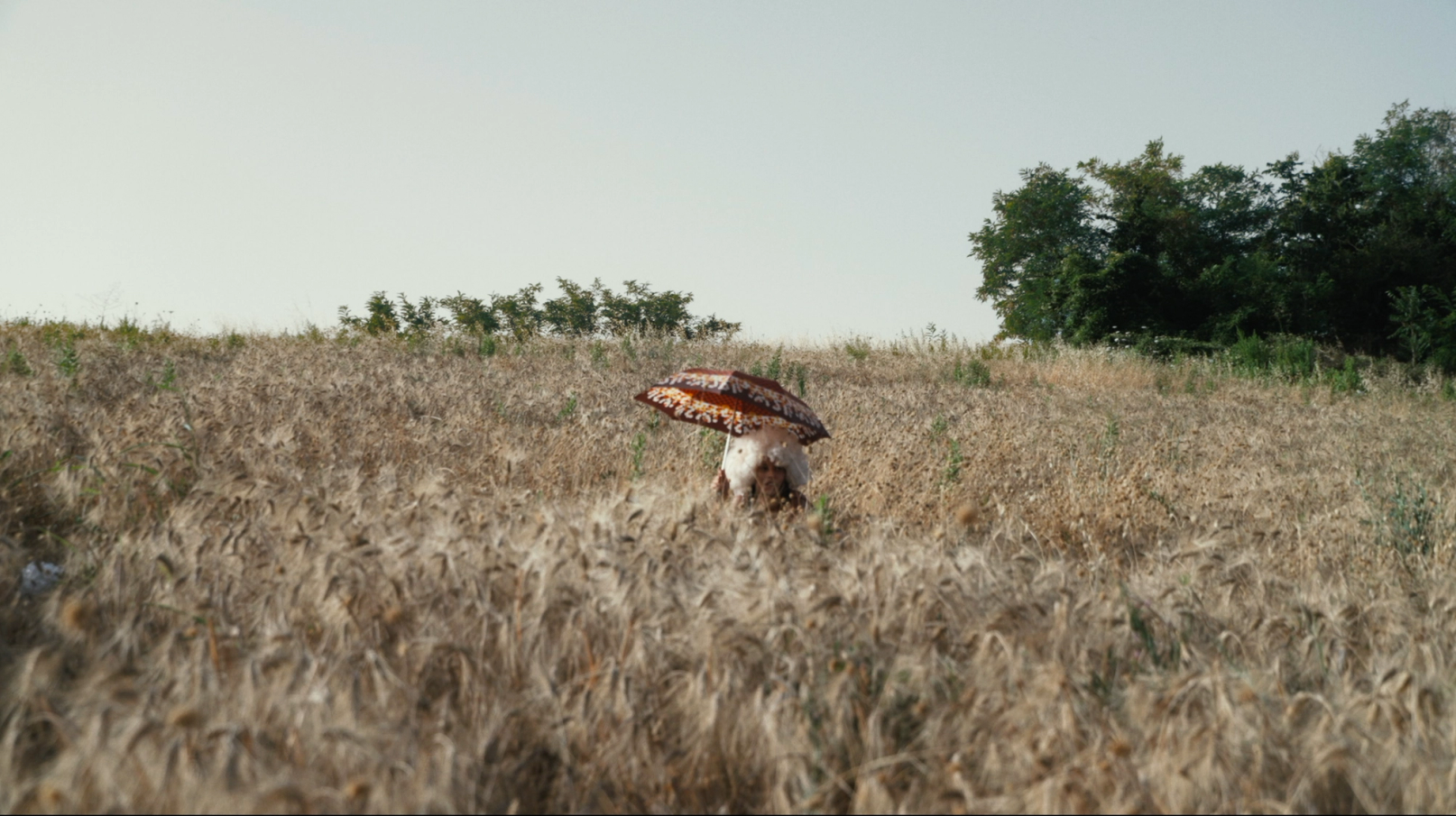
Scramble/Stories/Surface
study now steady is the grammar of Lewis’s practice put forth for study, as a form of study that forms performance. One way of knowing, or attempting to know, without naming.
Think of the top floor of Ligia Lewis’s exhibition as a ricochet, pinging across a grey hallway with two distinct endpoints: a gallery at either end. A pair of life-sized lightboxes facing each other, linked in the middle, which viewers enter whole-bodied, alongside the bright outline of dancing bodies. Sounds from one room occasionally seep into/undergird the other, at a distance. On one end, a live open practice unfolds in a bright space lit by windows and the skylight above; at the other, a not quite light-locked, cavernous screening room keeps a film on loop in darkness. In a lightbox, the diffusion of the light source into even coverage is key for creating contrast and highlighting detail, even if (and precisely because) the inner workings of producing that contrast are more granular.1 Differently, both ends of the hall rely on the self-figuring of dancers against the bright behind them.
On one end, study now steady (2023). A single sliver of bleacher benches along two entire walls creates a slippage between viewer/performer, stage/studio. “Dancing,” Lewis says in the exhibition text, “[produces] its own theoretical framework, its own set of rules, and its own ethos, coherent to itself.” Inside improvisational scores from Lewis’s past works, dancers decay, reorient, and construct compositions together in high contrast against pale pink walls and industrial windows, framing themselves again and again with a clarity of line/sound/gesture that intimates without mimicking recognizable relations.
Draping themselves on diagonals and against corners is what sticks most in memory, attunes most to the frame and most disavows it. Seeing you seeing me, they intone. Stillness, stroke, line, lay, cross, extend. The work of leg lowering getting loud leads to hand flail, and back around to still and the slaps and claps in this high-roof room reverberate on the Marley floor, a rubbery sound familiar to dancers for scorching skin. The performers take form from afar at first, through the doorway-as-frame, as flesh/body/shape in bright cotton clothes. Play-filled intensity. Drag one person here, another there, hands reach and release, catch; smile with the action of being pulled/placed, allowed to languish sweet with sweat and together; forehead to foot, patting. Facts are simply / Perceptions and surfaces / On the ground / We go round and round / Fall on the ground. Body lines align. Something about it being live leaves us audience to linger and trail into the hall for chatter, letting the room itself stay pristine with what has transpired.
Here, choreography is bodies smashing, faces warping, gestures and states forming and unforming, twisting, posing, playing, and practicing. Lewis’s work often has a scrambling effect on signs, symbols, and meaning-making, but rather than the postmodern dance tendency to reveal the scoring beneath the event as or in the performance, Lewis’s own machinations and the performers’ real-time calculations are rarely fully visible beneath the sheen.2 But study now steady is the grammar of Lewis’s practice put forth for study, as a form of study that forms performance. One way of knowing, or attempting to know, without naming.
At the other end of the hall, A Plot A Scandal (2023). Lewis’s work often begins with a story. Not necessarily as an opener or entry-point (though sometimes),3 but as a foundational element of the structure, trajectory, trope, and/or ambient aesthetics of preexisting narratives. Without nonchalance, this video work takes a period of time and a network of places as its playthings—or rather, the scandal of slavery’s expansive reach, which arrives as fact and feeling structured by a narrative arc that tells no single story. Baroque clothing and wigs, cobblestone streets, tableaux vivants, signs of death (scattered skulls), legal language (spoken with paced precision)—playing with the trappings of colonial power creates a world unpopulated by whiteness but rife with its regimes. Amidst old-world passageways and pastoral landscapes, marked by the ringing of church bells, the video cuts again and again to enclosed scenes: an interior, dusky glow against a theatrical cyclorama that turns even cream corsets and bones to sepia and skin tone (this skin). Silhouetted, Lewis and dancer Corey Scott-Gilbert are busy, at wit’s end but without panic—desperate expressions curdled and curled. Quick camera cuts ensure there’s no way to know:
Who is the clown here? The animal? The monster? The caricature? The landowner? The owned? The dead? The dancer? The desiring body? The body going through the motions? The king? Who is commanding and who is being commanded? Who is saving and who is saved? Who is made to care, is caring, is cared for? Who, really? And what have they been up to, all along? Any tenderness here is built to behave fiendishly. The unspoken story: We will care because we own you; we will own you because we care. Where do you go when empathy is “the central technology of the racial contract drawn up, and signed, by whites”?4
But the word “revenge” is the very first whisper in the film’s soundtrack, and the final word is neither language nor old Europe. It is rather a dance with spirits flowing through, caressing, and bumping against tongue, cheek, back of mouth, edge of spine, curve of nape, elbows, and loose fists, flowing through hypnotic as Lewis boxes air, strolls, crosses heart (hoping, plotting, revolting), an attempt at moving as a kind of beyond.
NOTES
1 Not unlike how a proscenium theater distracts from its complex lighting apparatus to focus attention with its glow, or how gallery lighting maintains a wash of light even if the viewing angle changes.
2 Not “sheen” as in surface-level depth, but rather as Tina Post uses it, as “aesthetic critique of the subject/object status of the black body”: as performative strategies (sometimes even used in performance) for creating surface tension, in which layered material and conceptual complexity manifests aesthetically, such as blackbody Blackface and deadpan. See Post, “Williams, Walker, and Shine: Blackbody Blackface, or the Importance of the Surface,” TDR: The Drama Review 59, no. 4 (Winter 2015): 83–100; and Deadpan: The Aesthetics of Black Inexpression (New York: New York University Press, 2023).
3 For example, Water Will (in Melody) (2018) includes a morphed but verbally conveyed retelling of “The Willful Child” by the Grimm Brothers, a tale which was also picked up by race and cultural theorist Sara Ahmed in Willful Subjects (Durham, NC: Duke University Press, 2014).
4 Sadhara Bery, “White Empathy: A Technology of White Supremacy,” in On Whiteness (London: SPBH Editions; New York: The Racial Imaginary Institute, 2022), 128–29.
Tara Aisha Willis, PhD, is a dance artist, independent curator, and writer. Currently she is Lecturer in Theater and Performance Studies at the University of Chicago, and most recently served six years as Curator of Performance at the Museum of Contemporary Art Chicago. Select writings appear in publications by Getty Research Institute, Danspace Project, Center for Book Arts, The Black Scholar, University of Illinois Press, Women & Performance, Performance Research, Brooklyn Rail, Movement Research Performance Journal, Performa, Wendy’s Subway, and Soberscove Press. She has performed for Will Rawls, Yanira Castro, Paulina Olowska, devynn emory, Kim Brandt, Anna Sperber, and others, and was a dancer in the 2016 "Bessie" Award winning performance, the skeleton architecture.

